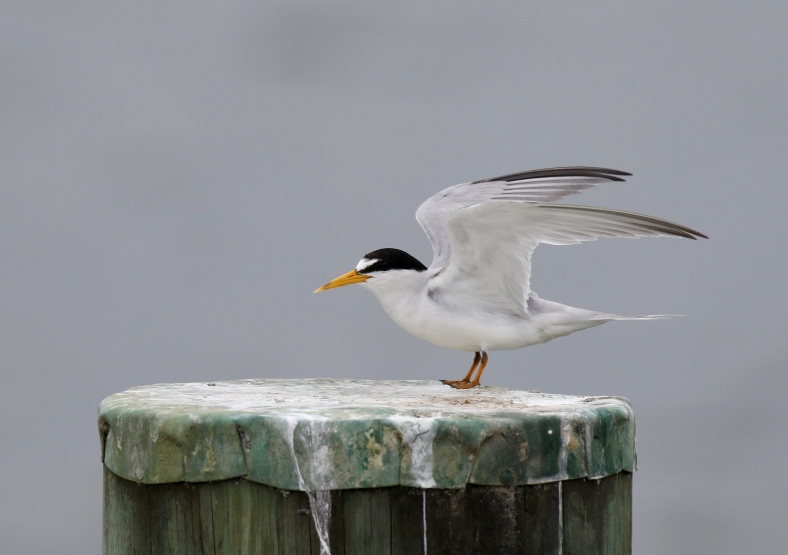“Least” is the superlative on the short end of the scale. It’s a modifier that may be complimentary or derogatory but in the birding world it just describes size. I was noticing some terns roosting on the dock pilings this week. The Royal was large and obvious, while the smallest were more vocal and active, hovering and diving while the others just watched. These were Least Terns and brought to mind the other common “least” birds, the sandpiper, bittern, and flycatcher.
For me the Least Terns were the easiest terns to learn and ID, mainly due to their size and an obvious marking. The ID’s become much muddier for the next size up when you have to deal with the Common, Forster’s, and Roseate Terns with their subtle differences. In addition to being our smallest tern, that white chevron on the forehead of breeding adults is unique. The Little Tern is a similar-appearing East Coast vagrant from Europe, but other than that potential confusion, the Least Tern is usually an easy ID.
This little bird has been losing it’s competition with bathers, beachcombers and condos for nesting sites on the beach, but now you do find some roped-off dunes. The bird’s innovative and resourceful impulse has led it to “protected” nesting on the gravel roofs of shopping plaza, including our local Acme. I guess there is some benefit to all these big box stores. Thankfully the milinery hunters of the 19th century are no longer a threat. Say goodbye to this bird in late summer as it completely leaves the mainland U.S. and northern Mexico for unknown wintering grounds further south.
The Least Sandpiper also comes in as the perceptible light-weight of the peeps. The guidebooks only list it as 1/4 to 1/2 inch smaller than the Western and Semipalmated Sandpipers but the size difference is noticeable when you see them in a group. Often however, this bird congregates in small feeding flocks away from other larger shorebirds in sheltered coves and along marsh edges. It’s the most common sandpiper to be seen on small inland lakes. I find that the pale yellow legs is the most helpful field mark–the other peeps have black legs. I know the caution about muddy legs obscuring the yellow, but you usually can find one bird in the flock who likes to keep her legs clean.
The birds breed in Canada and Alaska but appear along each coast and the Great Lakes in mid-June, hanging around through September. I find them in Florida and the deep south all winter. I’ve learned from experience and fellow photographers that you really need to get low on the beach, kneeling or lying prone to get good shots of the shorebirds. I usually just kneel.
For the other two “least” birds the modifier is valid for not just their size. The Least Flycatcher and Least Bittern are among the least often seen, least photographed, and least properly ID’ed birds, at least for me. Forgive me for showing photos of related birds only–I’ll keep stalking the others for decent shots.
The Least Flycatcher is common here but easily confused with the other 4 members of the genus Empidonax that are also seen in the Eastern U.S. They all have wing bars and eye-rings and their size differences are only measured in 1/4’s of inches. This is where “advanced birding” techniques apply. The best differentiaters are their songs and habitat preferences, but you’re often left with just calling them all “Empids”. The Least FC prefers the partly open edges along woods and has a loud “che-beck, che-beck…” song.
I saw the elusive Least Bittern at a distance in the STA5 water control area in south/central Florida in 2012 with a large group of experienced birders. Despite its relative abundance the wonderful camouflage and secretive feeding habits make it one of the more difficult sightings. I think it’s closest look-alike is the Green Heron rather than the larger American Bittern. I’ll show you photos of both–it’s the least I can do.







